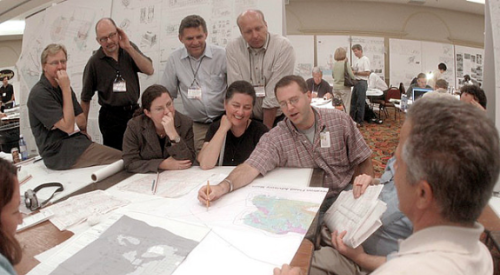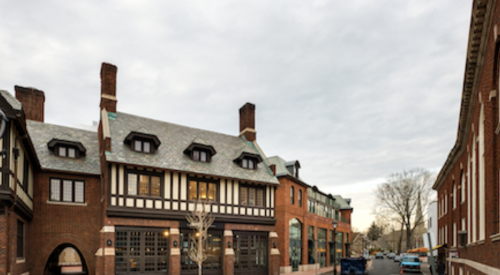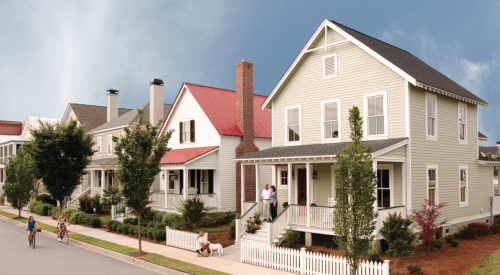|
Third-generation builder/developer John Knott is used to being told that what he wants to do can’t be done. It’s the mantra skeptics always attach to projects that challenge conventional development guidelines, and those are the only kind Knott builds.
“It all comes down to how you define the business you’re in,” says Knott. “I’m not in the land business. Not in the sticks-and-bricks business either. I’m in the business of building community and housing the human family.” With that focus, one this South Carolina developer learned firsthand from family and from professional mentors such as Jim Rouse of The Rouse Co., it’s impossible to continue to use land, create communities and build homes the same way it is done today.
Two of Knott’s most recent projects showcase the result of his thinking put into action. At Dewees Island, an upscale residential community on a barrier island 12 miles north of Charleston, S.C., Knott began development of the project by deciding what not to build. “I always look first to inventory the assets of the site that need to be protected,” he says. This inventory resulted in a plan that meant only 420 of the 1,206 acres were touched by development.
Dewees residents also must meet stringent environmental and architectural controls, including engaging a licensed architect and landscape architect, as part of a comprehensive design process. Passive solar heating, daylighting and orientation to prevailing summer breezes must be incorporated into the design. A home must be oriented to its site and existing foliage.
While this planning and these guidelines can manage the impact of the built environment on the natural one, they are only part of the equation, says Knott. “It’s not enough to live in an environmentally responsible home in a sustainable community. People need to feel a connection to others in the community, and it’s our job to build in opportunities for human connection.” At Dewees, Knott created a series of “accidental meeting places” where residents interact — a community post office, public beaches and public marinas.
Now Knott and a team of experts are taking the lessons of the island development and seeking to create a “Dewees in the city” on a much larger scale. The Noisette Project, a billion-dollar, 3,000-acre sustainable redevelopment plan for an area of North Charleston, S.C., is the largest urban reclamation project under way in the United States today. The scope of the project is massive and includes:
- At a shuttered naval base, the creation of a three-quarter-mile waterfront park along the Cooper River. This will connect to a 200-acre urban park surrounding Noisette Creek.
- 7,000 new housing units.
- 3,000 rehabilitated housing units.
- 6 million to 8 million square feet of commercial and retail space.
Phase One of the The Noisette Project is a comprehensive master plan that includes guidelines for:
- ecological restoration strategies.
- existing and proposed zoning, land utilization, mix of building types and public space elements.
- building-density elements including floor-area ratios, height and massing.
- sustainable overlay zoning for the entire project.
- sustainable partnering of resources.
- developing a new model for city financing and infrastructure capitalization.
Though this list just scratches the surface of the goals for the Noisette team, it includes the major points of what Knott describes as “corrective engineering.”
| “I’m not in the land business. Not in the sticks-and-bricks business either. I’m in the business of building community.” |
“As an industry and as a society, we’ve walked away from the ways communities used to work,” he says. “Forty and 50 years ago we didn’t have the segregation of use that is rampant in our culture today.” According to Knott, this current paradigm results from a business model based too much on short-term, bottom-line economics instead of long-term sustainability.
“We’re dealing today with the effects of the laws of unintended economic consequences. The problems of city finances and infrastructure needs, the durability of houses, energy-consumption issues — we actually planned for the mess we’re experiencing now.”
To effect a different sort of future, development at Noisette involves a holistic team that cuts across every discipline. Beyond Knott, team members include:
- James Augustin, vice president and co-founder. Augustin was director of base closure for the U.S. Navy Civil Engineer Corps. He was also one of the national leaders focusing the Navy on sustainability.
- Arthur Titus, vice president and partner. Titus has more than 20 years’ experience in home building and community development with some of the industry’s best builders — John Wieland Homes, The Ryland Group and Ryan Homes.
- IBACOS, which brings together manufacturers, builders, developers and experts in the home building industry to create better, more durable homes.
- EQA Landmark Communities, the development arm of IBACOS, which brings together developers, builders, suppliers, designers and engineers to create communities and homes that make good on its name. E stands for efficient use of time, materials and resources; Q for high-quality construction and craftsmanship; and A for homes that are adaptable to changing needs, lifestyles and future building technologies.
The development team includes 13 other individuals or firms, covering nearly every discipline. This marriage of expertise reflects both the personal and professional world that Knott has always known. “I grew up in the guild tradition of building,” he says. “My grandfather and father worked side by side with the master craftsmen and understood how changes in one area necessitated changes everywhere else. Working with Jim Rouse taught me how the new had to integrate with the existing environment. Nothing exists in a vacuum.”
This approach — this memory — can serve the industry well today. “In the development world I believe we have to model ourselves after a Dell Computer,” Knott explains. “We have to become the integrator that brings together all the players and create a systems approach to community planning and home building. We’re stuck in a pieces-and-parts approach to building, and the result is higher cost for everybody. We can achieve tremendous savings in the building business through systems thinking.”
Knott also believes that the time for change is now. “There were a lot of things that were done because we weren’t aware of a better way, but now we know. When you don’t know, you have the excuse of ignorance, but once you are aware, you have liability. We are in a position in the building industry today where we do know. The answers are here.
“If our industry, which is populated with the last great entrepreneurs, looks hard at its own base of knowledge and uses it, there will be a tidal wave of positive change.”












